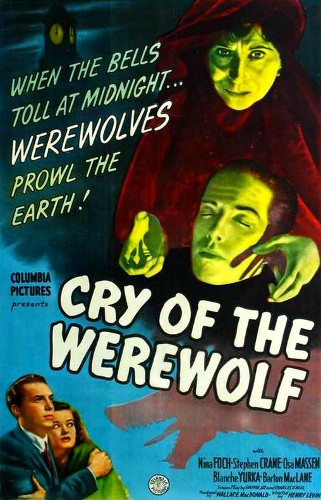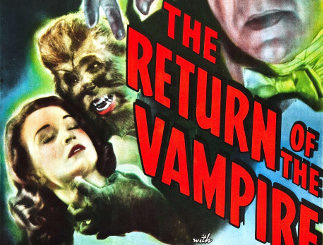Cry of the Werewolf (1944)
Directed by: Henry Levin
Written by: Charles O'Neal, Griffin Jay
Starring: Blanche Yurka, Nina Foch, Osa Massen, Stephen Crane
USA
AVAILABLE ON DVD [Public Domain Only]
RUNNING TIME: 64 mins
REVIEWED BY: Dr Lenera, Official HCF Critic
Professor Charles Morris runs an occult museum in a building that was once the home of gypsy queen Marie LaTour and is about to publish a book about her full of new information. Meanwhile her descendant Celeste sets off from her gypsy camp to prevent this stuff seeing the light of day. When the Professor’s assistant Elsa goes to pick up his son Bob from the train station, they return to find him killed. It seems that an animal, probably a wolf, was the culprit, but how did it get in and be able to throw manuscripts into a fire?….
When is a werewolf not a werewolf movie? Some seem to say when the creature is an actual wolf rather than a werewolf, and I recall reading a review of Cry Of The Werewolf a year or so ago that claimed that it shouldn’t therefore be considered as one because the film features a wolf. But in that case perhaps the greatest werewolf movie of them all An American Werewolf In London shouldn’t be classed as one either? More to the point, of course, is if this film is any good. I sought it out because it began life as a direct sequel to The Return Of The Vampire which I reviewed a few weeks ago. Bela Lugosi was intended to come back as the Dracula-substitute Armand Tesla as was Nina Foch as his potential bride in what was supposed to be called Bride Of The Vampire. But somewhere along the line [info really is pretty scarce about this one] it metamorphisised into Cry Of The Werewolf, a film that doesn’t seem to be very popular even with vintage horror fans and which hasn’t even had an official DVD release, though being another public domain title it’s easy to find copies on disc for almost nothing. But I have a special fondness for werewolf movies, so I just had to buy and watch it and tell all you good people what I thought.
In short – it’s not very good – and I reckon that, despite its scant running time which sadly seems a bit longer, only viewers who really do watch a lot of very old movies [yep, I’m a ‘Talking Pictures’ fan] will find a modicum of entertainment in it, unlike say The Wolf Man which, with its pace and feel and involving plot line is still a film which I think can easily be enjoyed by many even today. This effort doesn’t contain much in the way of excitement, but nor does it have much of that thick atmosphere which for us fans of this type of movie can make up for an awful lot of flaws. Much of it is set inside a rather small museum, but only sometimes has much of an attempt been made to make the most of the setting. Story wise it does have its interesting aspects in what seems more inspired by Cat People than previous werewolf pictures, though some of these are just rushed through, while you’ll be hard put to notice a Val Lewton influence in the style – and this film could have really done with it. Which reminds me that I’ve been meaning to review the Lewton films and extol the virtues of classics like I Walked With A Zombie and The Seventh Victim for some time now. But for now I have to try to find notable things to say about Cry Of The Werewolf, which could be difficult as it’s one of those films that isn’t especially bad, but is hardly good either, and which therefore just plods along not doing much very with its material which, even if you’re not too keen on the idea of someone turning into a proper animal rather than a half-human half-animal creature, did have some potential.
Saying that, it does make an amusing misstep right from the beginning where, after the main titles, we have to read some gobblygook beginning with “the ancient belief is still held by many that anything that happens in the world is never lost”. After reading through the whole text three times I came to the conclusion that we’re basically being told that events will always repeat themselves, but honestly, it’s not a good start is it? So, we begin proper with some visitors getting a tour of this museum. First they’re in a replica vampire’s crypt that contains a fake skeleton with a stake in it, and I wondered two things – first of all if this was a holdover from one of the early scripts where it was probably the skeleton of Armand Tesla, and secondly if the writers of Universal’s House Of Frankenstein which came out a few months after Cry Of The Werewolf were inspired by this as that film had somebody exhibiting the actual staked skeleton of Dracula at a traveling sideshow. The guests and us are then shown into a voodoo room where the tour guide [I absolutely love what he says at the start of each session “much to be seen, more to be heard, and plenty to imagine”] says how Professor Charles Morris witnessed the transplanting of personalities – something that I expected to be later linked with developments in the story but which isn’t. Finally we enter the Marie LaTour room, the gypsy queen who’s become Charles’s main object of study, not long before we find out that Marie’s great [or thereabouts] grand daughter Celeste is around and living in a nearby gypsy camp and doesn’t want Charles to publish this new information that he’s found. This means that when Charles is found dead we know exactly who did it, especially when it comes to light that the original LaTour was a werewolf, something partly shown in a flashback. I guess they wanted to go down the “suspense instead of surprise” route, but that doesn’t work when not much suspense is actually created!
The sight of handyman Spavero stumbling out of the darkness traumatised by what he’s seen certainly makes up for the filmmakers not being allowed to show the sight of Charles’s torn apart body. And you soon learn something new – that infrared photography can detect the writing on burned paper as things don’t seem to match up regarding the killer. Spavero is the prime suspect, and he’s certainly involved with the gypsy plan, but it’s got to be Celeste hasn’t it? Meanwhile, Lt. Barry Lane [Barton McLane playing a cop, well fancy that] doggedly tries to solve the murder without resorting to occult explanations which is difficult when things don’t add up like fingerprints not matching. There’s a bit of confusion involving a secret passageway where not all the comings and goings seem to have been properly worked out, then a love triangle develops when Bob [engaged to Elsa] and Celeste become attracted to each other. One might wonder what not one but two highly attractive women see in this guy considering Stephen Crane’s terribly bland acting. Celeste works some cruel magic on Elsa, but this comes along too late and would have been better off as a major part of the plot that began much earlier on. It’s almost as if they had to tear out large chunks of the second half of the film, maybe because they ran out of money.
Things rather thankfully wind up with a few cops vs. a wolf in the museum at night, though surely we could have done with at least one policeman getting killed? The changes from human to wolf are either done in shadow or a cut from and to different legs, but you can see that they used a real wolf for many of its scenes. It sometimes seems a little docile, but can you imagine them using a real wolf today? There’s a half decent stalking set in the woods, though oddly no fog at all. One thing this film is quite successful at doing is expanding the gypsy element from the concurrent Universal films. These particularly gypsies have a matriachal society and have curious rites such as only burying the dead on one particular day a year and leaving dolls with people. The professor gets a devil doll right before he’s offed while Elsa unfortunately finds a love doll in her beau’s coat pocket. Whoops! Unfortunately the script cheapens all this towards the end by claiming that the gypsies just worship evil. Can’t you just imagine the Twitter outrage if they’d done this today? Still, Osa Massen, a Danish actress I think I’ve only otherwise seen in Rocketship X-M, is really rather luminous as Elsa and Nina Foch is just tremendous as Celeste. She makes the character rather sympathetic despite her villainy, which is what it really should be in a werewolf [or should that be just “wolf”] movie. And the music score, comprising largely of stock music, does nicely incorporate Mario Castelnuovo-Tedesco ’s werewolf music from The Return Of The Vampire.
I’ve possibly been a little hard on this film. It does make some effort to be different and I’m sure that as a ‘B’ programmer in its day it did the job. But even to me – somebody who enjoys all kinds of horror films, goes to see every new release in cinemas if he can, and certainly likes his blood and gore yet whose heart in many ways still lies with the vintage movies of the Universal and the Hammer school he was enthralled by as a kid sneaking downstairs to watch illicitly while his parents slept, Cry Of The Werewolf really was rather lacking. This is a good example of where a remake could be a good idea, as there really is quite a bit of potential in the premise and some of the story elements for something pretty decent – but then only seem to remake good and well known films, don’t they?
Rating: 

















Be the first to comment